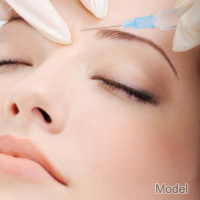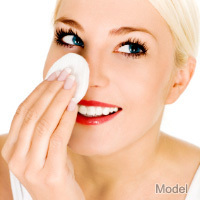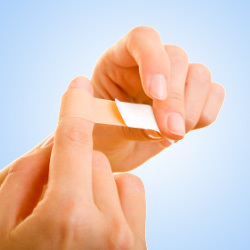Rod J. Rohrich's Blog, page 5
August 16, 2010
Cosmetic Q&A: Mini Tummy Tucks & Healing
 1. Does the mini tummy tuck remove any skin above the navel?
1. Does the mini tummy tuck remove any skin above the navel?
Dr. Rohrich: Absolutely not. That is the reason a mini-tummy tuck should be limited to only those patients who do not have extreme skin or fat above the umbilicus as this cannot be altered or significantly changed. A mini-tummy tuck is only good for patients with a high torso, little to no redundant skin above the umbilicus, and have had no children or only one at the most, because it does not tighten abdominal skin above the belly button. A mini tummy tuck does, however reduce the length of the incision and the recovery by one week.
2. Can you do a rectus muscle plication using a mini tummy tuck?
Dr. Rohrich: Of course, you can do a rectus muscle plication (or tightening of the abdominal muscle) of the inferior portion. If you use an endoscope, you can to it above the umbilicus or you can float the umbilicus and do the plication centrally. This procedure should only be done by people that have a long torso with a high umbilicus.
3. Why should you have swelling after a tummy tuck?
Dr. Rohrich: I think it is not uncommon to have some swelling, especially below the belly button for 3 months after tummy tuck. This should subside over time and if it doesn’t you may consider having an external ultrasound or massage in the area in the early post-op period.
4. How long should you have drainage after a tummy tuck?
Dr. Rohrich: It depends. It can be for days or up to 2 weeks in extreme situations. However, in most cases the drainage should end in 3-5 days, or less with current techniques of leaving the deep fatty layer as well as doing quilting or sutures to close the dead space around the drain sites. The key also is to wear compression and to limit physical activity and exercise for 3 weeks after surgery.
August 10, 2010
Breast Augmentation: 10 Patient Questions Answered
 1. Why do you put breast implants below the muscle?
1. Why do you put breast implants below the muscle?
Dr. Rohrich: There is very good scientific evidence in the literature to show that breast implants look more natural and feel better if placed below the muscle. It also does not obscure mammography (both silicone and saline implants) and there is good evidence based data to support that the implants (both silicone and saline) stay softer longer by a significant margin if placed below the muscle.
2. How do you prevent rippling in breast implants?
Dr. Rohrich: The ideal to prevent rippling is to decide pre-operatively what type of implant you need and whether it should be placed above or below the muscle. The optimal ways to prevent rippling or at least minimize rippling is to place the implant below the muscle, make sure there is adequate breast tissue, and not oversize or under inflate an implant if you are using saline or silicone implants. Sometimes the use of silicone implant may be better, especially in patient with no breast tissue as well as placement below the pectoralis major muscle. If you are using saline implants make sure you maximally fill it and not over fill or under fill, as that can cause more scalping or rippling. If you under fill, it can cause more deflation in saline implants. Remember, one can almost always feel any implant in the lower outside quadrant of your breast.
3. Why should you under or overfull saline implants?
Dr. Rohrich: One should never underfill a saline implant because that is a higher chance of having a deflation or rupture because of full flow problems. You should always maximally fill the implant so that it will get less scalping and no rippling in this area, and it will deflate much less.
4. Do you have to replace a ruptured silicone gel implant and why?
Dr. Rohrich: Yes, if there is radiographic evidence or an MRI it should be replaced for several reasons. Primarily, because long-term the silicone can cause small granulomas or small masses in the breast which can mimic breast tumors that may be similar to breast cancer and can disseminate throughout the breast. It is optimal to remove the implant with the capsule and attempt to replace with a new implant below the muscle. All implants need to be considered for removal at 10-15 years, whether the implant is saline or silicone.
5. How long should I wait before I have a ruptured silicone implant replaced or removed?
Dr. Rohrich: Replacement of implants that have ruptured is not an emergent operation, but it is one that should be undertaken within several months from the diagnosis. Over time silicone implants that have ruptured tend to leak and can cause more scar tissue formed by interaction around the implant. The procedure requires removing the implants and also the scar tissue around the implant. Therefore, in most cases, you do need a drain when replacing the implant. The recovery is brief – about 3-5 days.
6. Should one use high profile or moderate profile implants plus for sagging breasts rather than perform a breast lift?
Dr. Rohrich: In most cases I don’t think that it is prudent to use high profile implant or moderate profile implants (saline or silicone) to correct sagging breasts as this is not the solution. If you truly have breast ptosis or sagging breasts you should do a breast lift with or without implants. Obviously, if patients want a lift and more upper fullness they should do a lift with implants (with moderate profile implants) in most cases.
The problem with high profile implants is that they have not been adequately studied and may have much higher incidence of breast tissue and glandular thinning and subsequent long-term rippling effects, whether they are silicone or saline, although this has not be studied extensively.
 7. Does the number of cc’s in a breast implant correlate with the breast size?
7. Does the number of cc’s in a breast implant correlate with the breast size?
Dr. Rohrich: It usually does not, because it depends upon the size of breast that you are beginning with. The resulting cup size does not directly correlate with the implant size. Just as different size, whether it is a B, C, or D cup varies from patient to patient and from retailer to retailer, there is no way to guarantee that one will have a B, C, or D cup breast after implants. The goal is to make them proportionate to the patient’s chest wall diameter, amount of breast tissue the patient has and their size and shape. It is very important not to over augment patients, as they will then have further movement of their breast tissue out to the outside (or lateralization) which will cause distortion and the breast will look too large for the patient’s body and chest wall.
8. How can one breast be hard and the other breast be soft?
Dr. Rohrich: Yes, this can occur since we did not know the real cause of capsular contracture (breast implant hardness). It is uncommon for capsular contracture to occur, especially with saline implant below the muscle, but is saline implants do get hard they will begin getting hard earlier than later (the first several 3 months) vs. silicone gels, if they get hard, will get hard progressively over time. One can attempt to do early aggressive breast massage for perhaps 6-8 weeks. However, if capsule contracture develops then a simply inferior capsulotomy or release of the scar tissue may be all that is needed, especially with saline implants, to restore shape and symmetry. This is done easily as an outpatient under IV sedation.
9. What is the potential for loss of nipple sensation; numbness on one side and not the other.
Dr. Rohrich: It is not uncommon to have some sensory changes after breast augmentation, especially if there is a larger implant. Most of the time sensation does return, especially if placed below the muscle, therefore one should wait 3-6 months for the sensation to return. However, it is acceptable to have some nipple sensation loss with breast augmentation. The ratio of sensory loss from breast augmentation is 5-10% with the inframammary fold incision being the least (lowest) ratio of nipple sensation loss.
10. How do you make cleavage with breast implants?
Dr. Rohrich: It is somewhat a myth that breast implants will create significant cleavage. It depends more on the shape of your breasts and the diameter of your breasts pre-operatively as well as the degree of breast augmentation and the amount of breast tissue that you have. Often, if you have an average chest wall size, there is a better chance for having improved cleavage. However, it is not a guarantee and just increasing the size does not necessarily increase breast cleavage. It is actually counter intuitive as with the implant the breast is actually pushed to the side and actually diminishes the cleavage amount one would anticipate.
July 27, 2010
Cosmetic Q&A: Ethnic Rhinoplasty
 Question: Is rhinoplasty performed differently on a person with a non European ethnicity?
Question: Is rhinoplasty performed differently on a person with a non European ethnicity?
Dr. Rohrich: Ethnic rhinoplasty is considered a type of specialty rhinoplasty, like secondary or revision rhinoplasty. When we talk about ethnic rhinoplasty, we are talking about both the differences in the surgical approach to an ethnic nose as well as the way you approach and analyze this type of nose to retain its ethnic origin. It is very important to understand that true ethnic rhinoplasty focuses on preserving ethnic qualities of the nose while reshaping it. A person’s nose is a defining ethnic facial characteristic and it should not be the intention of the surgeon to significantly alter those basic ethnic features. Surgeons must take great care to maintain the patient’s ethnic harmony.
There are several challenges with ethnic rhinoplasty which are not present in a more traditional rhinoplasty and make it a more difficult type of surgery. The skin is usually thicker, which can obscure the underlying structures of the nose and make it more difficult to predict the results. The nasal framework tends to be more delicate, requiring more care and often necessitates the use of cartilage grafts to achieve good results. Darker skin requires more care of the incisions during closure to help minimize scarring. Overall, ethnic rhinoplasty often requires a more complex and elaborate surgery in order to be successful.
If you are seeking a plastic surgeon which has expertise in ethnic rhinoplasty make sure you do your research very well. A true expert in this area has written about it, lectures on this topic, and teaches others how to perform this type of surgery. Look though the doctor’s CV and note any publications and courses he has given on Ethnic Rhinoplasty, which might also be listed as Non-Caucasian Rhinoplasty.
As plastic surgeons, we are focused on getting good results and many will not attempt to perform ethnic rhinoplasty, preferring instead to refer them to a surgeon that regularly performs these difficult procedures. This is why there are not many rhinoplasty surgeons which are highly experienced in ethnic rhinoplasty in the USA.
June 1, 2010
Cosmetic Q&A: Targeted Liposuction for Small Areas
 Question: How effective is liposuction for a small area, like my ankles?
Question: How effective is liposuction for a small area, like my ankles?
Dr. Rohrich: Targeted liposuction can be very effective for certain isolated areas where skin tone is good. Most common areas are under the lower arms, neck area, calves and ankles, back and flanks.
For target areas such as these, the surgeon will use a small, fine cannula to reshape and contour the area carefully. Finesse in the use of these smaller instruments is essential, as is experience in the most sophisticated liposuction like ultrasound assisted liposuction.
They key to avoiding an unnatural look is to make sure not to over suction the area and to operate carefully to prevent depressions or deformities. The goal is to gracefully contour the area to make it more shapely and the surgeon’s aesthetic sense plays a major role here.
This surgery is usually performed as an outpatient procedure and patients will wear compression garments for about two weeks after their surgery. These garments will help improve post operative healing and reduce swelling in a uniform manner.
After your surgery, weight gain or loss will usually not effect your results as much as a more traditional circumfential liposuction which can be more dramatic with weight change. However, keeping a stable weight, with change being less than 10 to 15 lbs in either direction, will help to best maintain results and of course innate genetics always plays a major role as well.
May 27, 2010
Cosmetic Q&A: Retin-A the Gold Standard of Skin Care?
 Question: Is Retin-A still the gold standard for skin care?
Question: Is Retin-A still the gold standard for skin care?
Dr. Rohrich: Absolutely. The only skin care agents that truly have a scientific basis are the retinoids, specifically Retin-A. There is a considerable amount of clear, real science which shows that long term use of Retin-A decreases the effects of photo aging, brown spots and increases the dermis.
Normally, our skin turns over every 6 weeks, but use of Retin-A significantly increases this rate to as little as 6 days and in the interim allows you to increase the dermal thickness. Retin-A also enhances the production of collagen in addition to blocking agents that help break down collagen. This reverses some of the aging effects of sun damage.
Perhaps one of the biggest problems we have with retinoids is patient compliance and the early irritation. This is where the guidance of a skin care expert is important, helping you to apply retinoids with a more gradual manner or providing for a mild, more tolerable formulation.
Retin-A is usually prescribed to be used once a day before bed, but some patients may need to start with 2 to 3 applications a week and ease in to daily use.
May 17, 2010
Cosmetic Q&A: After Rhinoplasty
 Question: Does rhinoplasty hurt?
Question: Does rhinoplasty hurt?
Dr. Rohrich: Rhinoplasty in general does not hurt significantly, if at all. Even when doing the fractures of nasal bones, this is really not an issue. The procedure is usually done as an out-patient under general anesthetic so that it is a very comfortable almost pain free experience.
Question: How long should you wait after rhinoplasty to get a secondary rhinoplasty?
Dr. Rohrich: In general, it is important to wait at least 1-year in most patients and in secondary patients I wait 1 to 1 and a half years. This is especially important if the patient is male, a patient with thick skin, or a patient who has had multiple previous rhinoplasty procedures. Rhinoplasty is the most difficult operation in cosmetic surgery and a secondary rhinoplasty is a order of magnitude more difficult. It is very important to not do these operations too early, as all you will get is more scar tissue and swelling and therefore another unsatisfactory result.
For secondary rhinoplasty, it’s extremely important to seek out someone who has experience and expertise in rhinoplasty. The gold standard is to find someone who performs this procedure as a significant part of their practice, has written about it and teaches it, and has advanced the art in this area. That is the golden triad for a true expert in rhinoplasty.
Secondary rhinoplasty is a very, very difficult operation and it is especially crucial that you to go the distance to find someone who can do this operation for you, as you can only have so many operations on your nose.
Question: Is nasal packing after a rhinoplasty necessary?
Dr. Rohrich: Absolutely not. There is no rationale for nasal packing in a routine rhinoplasty. Most of the time if you are not doing a functional septal work, no packing and splinting is necessary. If splinting is required a small splint is placed temporary, which is then removed in 5-7 days.
May 14, 2010
Cosmetic Q&A: Botox Use, Forehead and Mouth
 Question: What should I expect from a Botox treatment in the forehead?
Question: What should I expect from a Botox treatment in the forehead?
Dr. Rohrich: The key thing in Botox is to not paralyze the face. This paralyzed appearance being normal has been a myth with Botox and gives an unnatural result.
The true goal is to have a soft look with reshaping of the brow and forehead so that it looks natural and not fake. The natural look is the hallmark of an excellent Botox injector, and that requires skill, analysis, experience and an understanding of anatomy. You must seek out someone who is an experienced injector in Botox. A true expert is someone who teaching it, has written about it and does it daily. Those are the triad that one must seek out if you want to get excellent results.
I also see all of my patients in two-weeks, especially if this is a first time Botox injection, to see how they are doing and how they are shaping of the brow.
Question: Can you correct the downward sagging of the mouth from Botox?
Dr. Rohrich: Yes, it is a very nice, simple and good way to correct the downward turn of the lips at the corners of the mouth, by weakening the depressor anguli oris muscle. This must be done very accurately, so as to prevent lip asymmetries when smiling. It is a very useful technique.
I use Botox in the upper lateral portion of the lip a significant amount of the time when I’m doing lip enhancement to provide for increased fullness in this area. A cautionary note for patients – I usually only inject the upper lip and not the lower lip. If the injection is not done correctly the patient may have some difficulty puckering or actually drinking from a straw. However, that is usually not a problem.
May 6, 2010
14 Myths: Facelifts, Fillers, and Skin-Care

Dr. Rohrich addresses these 14 myths about facial cosmetic procedures including facelifts, non surgical rhinoplasty, botox, dysport, fillers, skin care, and aging along with the use of cosmetic surgery.
1. MYTH: Everyone ages the same in the face, so the same facelift procedure will work for everyone.
Dr. Rohrich: Not true. Recent groundbreaking work at UT Southwestern on facial fat compartments has shown that we all age differently. This has led to new and more natural ways to customize facelifts for the future. Additionally, the environment clearly plays a role in how we age. There are adverse effects on our skin from the sun, wind and tobacco, among other things.
2. MYTH: Facelifts marketed as in-office procedures – usually taking just one hour with local anesthesia and minimal recovery time – are safe and effective.
Dr. Rohrich: Many patients have been disfigured or experienced complications from procedures like these. If you want long-lasting changes that you’re going to be happy with, it’s better to get a real facelift from a Board-Certified Plastic Surgeon performed in a real operating room under sterile conditions.
3. MYTH: Topical Botox is replacing injectable Botox.
Dr. Rohrich: Not true… yet. Topical application of botulinum toxin A are still in the clinical trial phase. Early indications are that it may work in small areas around the eyes (crows feet) and that it may help make injectable Botox last longer. However, it’s difficult to say it will ever replace injectable Botox, as it doesn’t have the same ability to deliver the toxin to specific muscle areas with pinpoint accuracy.
4. MYTH: Botox is Botox. You can get it for $100 at a hair salon or spa, or pay a lot more to get it from a doctor.
Dr. Rohrich: In Botox, as in life – you get what you pay for! The price of Botox is set by the company (Allergan) that produces it. If you purchase Botox at a severely discounted rate, it’s possible that you’re receiving a very diluted form of Botox or perhaps something that’s not even real Botox at all. What’s more, in salons the product is often injected by people with insufficient training, which can result in problems like asymmetry and droopy eyelids or brows.
5. MYTH: Botox cures migraine headaches, acne and hair loss.
Dr. Rohrich: It’s very effective for both stress and migraine headaches if placed correctly. And there’s preliminary data to show that it does diminish acne and may stall hair loss as well, but more studies are needed. They’re being done now..
6. MYTH: Fillers and Botox are the new non-surgical facelift.
Dr. Rohrich: After a certain age, nothing can produce the results of an actual surgical facelift. However, the proper and skilled combination of Botox and fillers can certainly postpone the appearance of aging in younger patients. Botox can smooth the forehead while lifting and shaping the brows. Fillers can plump up the lips and cheeks and soften the nasolabial folds. The results aren’t permanent, but they require very little downtime..
7. MYTH: The “new” Botox – Dysport – is better and lasts longer.
Dr. Rohrich: The efficacy of Botox and Dysport is about the same. Both injectables are essentially purified forms of botulinum toxin A. Dysport may act somewhat faster and is expected to be about 15 percent cheaper. Dysport is currently being used in Europe and is anticipated to launch soon in the U.S. with FDA approval..
8. MYTH: There are over a dozen FDA-approved fillers on the market. A person should be able to pick the newest one or the one that best fits their budget since they’re all government-approved.
Dr. Rohrich: A practicing Board-Certified plastic surgeon or dermatologist is the most knowledgeable person to determine which fillers to use on the different parts of the face to give you the best results in a cost-efficient manner. A combination of different fillers with different properties is the preferred way for achieving facial rejuvenation. Some fillers are more viscous and don’t migrate as easily; others are more fluid and can plump larger areas. Some cost more because they last longer (like Radiesse, which can last well over a year in comparison to some other hyaluronic acid fillers which act for 6-9 months). Your plastic surgeon should be your guide..
9. MYTH: Permanent fillers are better and everyone should use them.
Dr. Rohrich: Permanent fillers in general have more permanent problems that can’t be removed without disfigurement. And they don’t age well with the patient – so don’t use them. Temporary fillers that last longer – up to 1-2 years – are optimal at this time..
10. MYTH: Stem cells from fat work so well they will replace all facial fillers used today.
Dr. Rohrich: Perhaps in the future, but not now, as we still have to refine how we harvest, grow and stimulate stem cells. But we’ll get there in the next five years!
11. MYTH: You won’t age naturally if you have cosmetic surgery.
Dr. Rohrich: When plastic surgery was in its infancy, surgeons focused on tightening the loose skin of the aging face. With further research done by UT Southwestern plastic surgeons, we now know that an aged appearance is not only caused by loosening skin but by the loss of facial fat. We can naturally rejuvenate the face by techniques that both lift and fill the face. Using these new concepts of fat compartments and fat replacements within the deeper layers, we’ve moved to the next generation of facelift technology.
12. MYTH: Non-surgical rhinoplasty can provide the same results as surgery.
Dr. Rohrich: Not really. Fillers can help make some bumps and depressions go away temporarily – the best ones to use are based on hyaluronic acid – but this solution doesn’t work for significant changes, nor do the results last more than 6-12 months.
13. MYTH: You can remove dark under-eye circles with a cream.
Dr. Rohrich: Unlikely. Under-eye circles can have many causes, including skin pigmentation, shadowing, thin skin and visibility of underlying blood vessels. Different procedures to treat these problems may include the use of Retin-A or bleaching creams, chemical peels or lasers, and potentially surgery to blend the eyelid-cheek junction.
14. MYTH: You can grow thicker, longer eyelashes by applying a liquid gel daily.
Dr. Rohrich: True. The gel is called “Latisse” and its active ingredient was originally developed as a drug to treat glaucoma. When used as directed, you can grow thick, long eyelashes in about 4-6 weeks. There are some side effects to consider, such as it can potentially darken light-colored eyes.
April 26, 2010
Cosmetic Q&A: Best Methods to Manage Scars?
 Question: What are the best treatments to manage and minimize scarring after surgery?
Question: What are the best treatments to manage and minimize scarring after surgery?
Dr. Rohrich: 90% of how you heal depends upon your genetic makeup as well as the location of the incision. In general, incision scars in the head and neck area usually heal quite well, especially those in the eyelid and nose areas. It is very rare to have any type of keloid hypertrophic scarring in these areas, even in patients of color.
There is a higher incidence of keloid and hypertrophic scarring below the clavicle (neck area) and especially in areas like the presternal (sternum area), the deltoid (shoulder area), and the back, so one needs to be cautious in these areas.
The most important thing, beyond the genetics, is to prevent infection, to do accurate wound closure, early post operative taping, sun avoidance, and massage therapy. The application of vitamin E or antioxidants has not been shown to significantly enhance wound healing or to mature the scar.



